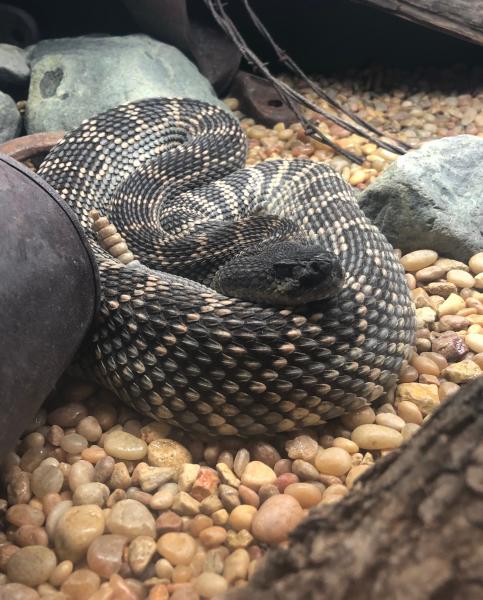 Snakes' historic reputation as killers produces both our fear and fascination.
Snakes' historic reputation as killers produces both our fear and fascination.
Of all the snakes encountered in the United States, approximately 10 percent are venomous. The most frequently cited statistics estimate that there are approximately 8,000 venomous snakebites each year in the U.S. -- these typically result in eight to 15 deaths.
Fortunately, fatalities from reptile bites are extremely rare when modern medical resources are available. But despite the fact that the recent death rate has dropped to less than 1%, serious symptoms are possible and bite victims must be seen in a medical facility without delay.
There are 15 different types of rattlesnakes in Arizona and all are venomous. Venoms are complex poisons which vary greatly in composition and potency among species and individuals. In addition to rattles, all rattlesnakes share some common physical characteristics:
- a triangular shaped head
- cat-like pupils
- foldable fangs
Watch videos of educational Periscope broadcasts about rattlesnakes.
Prevent Snake Bites
Taking precautions greatly reduces the possibility of snake bite.
- Leave wild animals alone. These animals want to avoid a human interaction. They will not attack, chase, or intentially bite.
- Be aware of peak movement times. Reptiles in Arizona are most active in the warmer months of April through October. During the hottest months, they will be most active at night. They may be encountered during the day in spring and fall or during a warm day in winter.
- Watch where you put your hands and feet. Try to keep your hands and feet out of crevices in rocks, wood piles and deep grass. Always carry a flashlight and wear shoes or boots when walking after dark.
- Dead snakes can bite. Never handle a venomous reptile, even after it's dead. Reflex strikes with injected venom can occur for several hours after death.
- Install outdoor lighting for yards, porches and sidewalks. If you see a venomous reptile in your yard, it is probably just "passing through." However, if you are concerned about a dangerous animal in your yard, seek professional assistance in removing it.
First Aid
In many cases, first aid performed in the field by the patient or companions only causes additional injury. The best first aid kit for snakebite includes your car keys and cell phone. Get help quickly if you are bitten
If you are bitten,
- Don't use ice or electricity.
- Don't use constricting bands or suction. Using "extractors" does not remove a significant amount of venom and the process can increase tissue damage.
- Don't give alcohol or medication.
- Don't wait to see if you get symptoms.
- Don't try to catch the snake.
- The snake may bite again.
- Capture will delay your getting to the hospital.
- Treatment will be the same no matter which kind of rattlesnake bit you.
- Do relax and move as little as possible.
- Do remove tight clothing, shoes or jewelry from the bitten limb.
- DO GO to the nearest medical facility immediately.
Patient Information
Below you will find helpful resources to support your recovery after a rattlesnake bite. If you have any questions about the information below, please contact us.
Rattlesnake Bite Discharge Instructions for Patients
Rattlesnake Bite Discharge Instructions for Patients (Spanish)
Physical Therapy-Foot and Ankle
Wound Care After a Rattlesnake Bite




